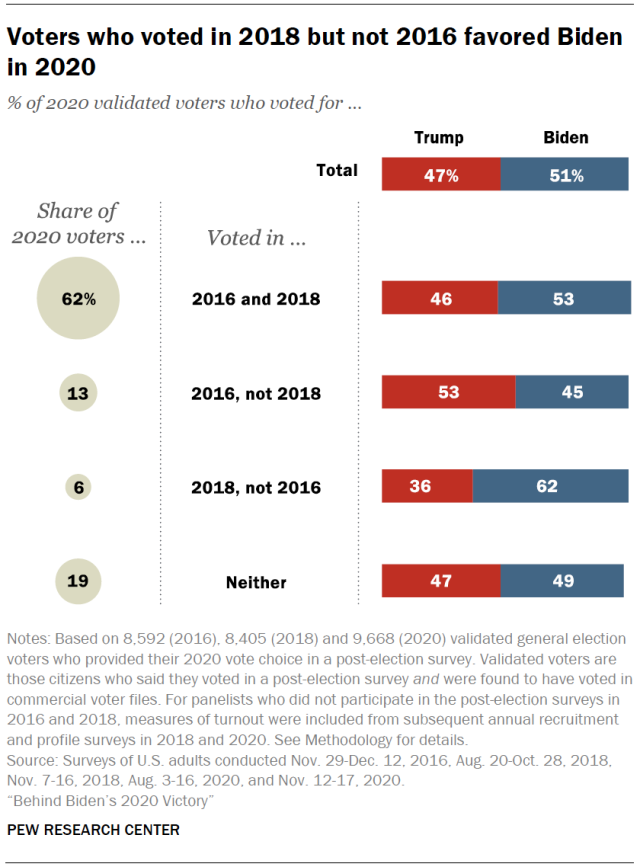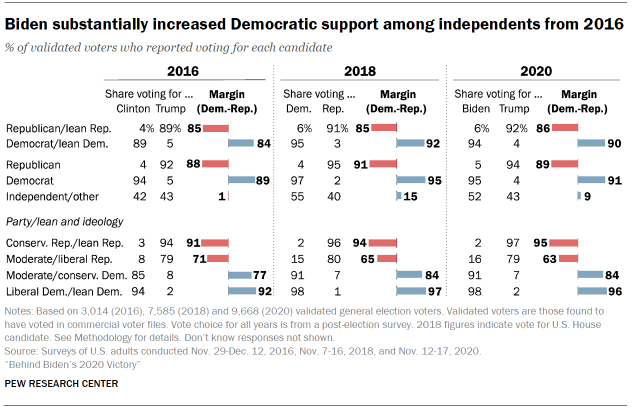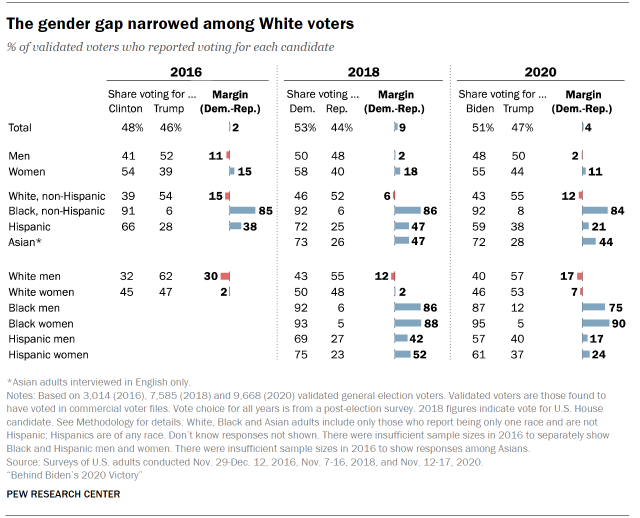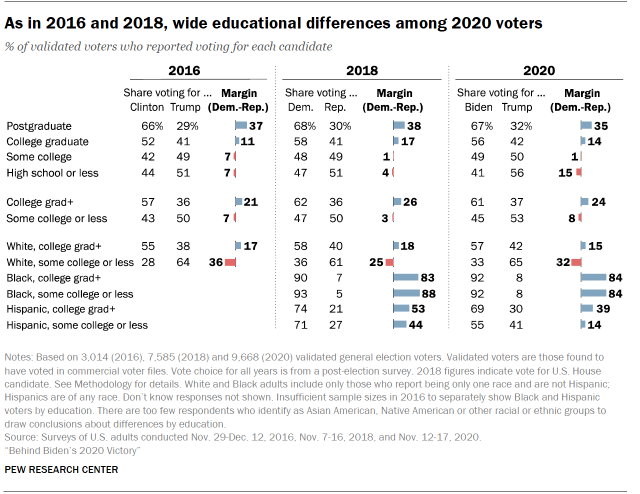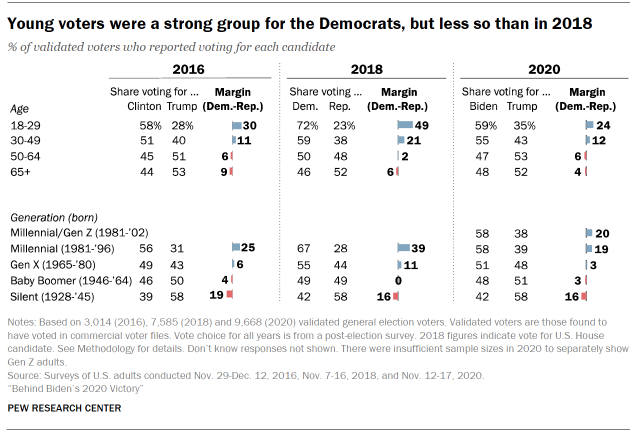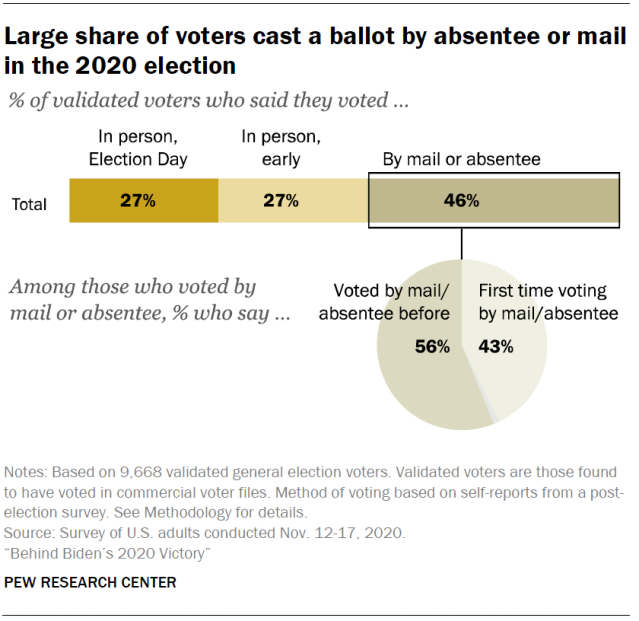2020 election study shows how Biden's gains with suburban voters and independents likely cost Trump the election (6 Pics)
A new in-depth study of the 2020 presidential election shows how former President Donald Trump expanded his support with Hispanic voters, millennials, and women and yet still lost to President Joe Biden, who severely cut into Trump's support from suburban voters.
The Pew Research Center's report published Wednesday surveys verified voters, those who reported voting in the 2020 general election and have a record for voting in a commercial voter file. The analysis examines both new voters and those who voted in one or both of the 2016 and 2018 elections. It paints a picture of the demographic composition of the electorate and how different groups shifted their support for the two major parties in ways that may reshape political campaign strategies for decades to come.
Voter turnout in 2020 rose 7% over turnout in 2016. A total of 66% of U.S. adult citizens voted in 2020, and both Trump and Biden brought new voters into the political process. But each candidate began with a base of support from the 2016 election that was largely unchanged. Among those who voted for Hillary Clinton and Trump in 2016, about 9-in-10 also voted in 2020 and stayed loyal to the same party.
Biden had an advantage with voters who skipped the 2016 election. Overall, a quarter (25%) of the 2020 electorate did not vote in 2016, but about 1-in-4 of these voters (6% of the 2020 electorate) did vote in the 2018 midterm elections. These new voters who showed up for the first time in 2018 and voted again in 2020 supported Biden by a margin of nearly 2-to-1 (62% to 36%).
As for those who didn't vote in 2016 or 2018 but showed up in 2020, representing 19% of the electorate, Biden and Trump split their support nearly evenly (49% for Biden vs. 47% for Trump), demonstrating how each candidate was able to bring new voters to the polls in 2020. But there was a significant divide in how people of different age groups voted. Biden trounced Trump among voters under 30 who voted in 2020 but not before, winning this group 59% to Trump's 33%. But Trump won new voters over age 30 by 55% to Biden's 42%.
The breakdown shows an advantage for Democrats among younger new voters that will pay dividends in the future if they are able to keep their support for the long term.
Biden's most significant gains were among suburban voters and independents, the groups that were likely responsible for his victory.
In 2016, Clinton won just 45% of the suburban vote. In 2020, Biden won a majority of 54% of suburban voters, pulling white suburban voters away from Trump by 12 percentage points. When Trump first won office he won white suburban voters by 16 points (54%-38%) but in 2020 Biden reduced that margin to just four points (51%-47%).
Independent voters went for Biden in 2020, 52% to Trump's 43%. This represents a substantial gain for Democrats over 2016, when Clinton and Trump very nearly split the independent vote evenly, 42%-43%.
Both Trump and Biden were able to consolidate support from voters who identified with their respective major parties or said they leaned either toward the Republicans or Democrats. Trump had 92% support from Republicans and Republican-leaning voters and Biden had 94% support from Democrats and Democratic leaners.
Though he lost the election, Trump made important gains with groups Republicans have been trying to reach for years.
Biden won a 59% majority of the Hispanic vote but Trump, with 38%, significantly improved Republicans' performance with this group over the 2018 midterm election, when Republicans won only 25% of the Hispanic vote.
The gender gap narrowed in 2020. Trump was able to win more support from women, improving from 39% support in 2016 to 44% support in 2020. Biden, on the other hand, won more support from men (48%) compared to Clinton in 2016 (41%).
Trump also improved upon his 2016 performance with urban voters by 9 percentage points, millennials by 8 points, whites without a college degree by 4 points, and rural voters by 6 points.
Black voters remained overwhelmingly loyal to the Democratic Party by a margin of 92%-8%. Biden's coalition of black, Hispanic, Asian, and other minority group supporters made up 4 out of every 10 of his voters.
Biden improved over Clinton among white voters without a four-year college degree winning 33% of that group's support in 2020 compared to 28% for Clinton in 2016.
Important generational shifts were a factor in this election. For the first time in decades, Baby Boomers and members of the Silent Generation made up less than half of the electorate in 2020 (44%). Generation Z and Millennial voters were strong Biden supporters by a margin of about 20 points. Gen Xers and Boomers were more evenly split along partisan lines.
The last key piece of data, and possibly a reason voter turnout was so high, is a record number of voters reported voting by mail in the 2020 election, many doing so for the first time. Almost half of the 2020 electorate, 46% of 2020 voters said they cast their ballots by mail or voted absentee.
A 58% majority of Biden voters reported voting absentee or by mail-in ballot in the 2020 election. Only roughly a third of Trump voters (32%) said they voted by mail. Nearly two-thirds of Trump voters (68%) said they voted in person either on or before Election Day. These differences match the election results, where Trump won voters who cast their ballots in person on Election Day 65% to Biden's 33% while Biden won absentee and mail-in voters 65% to Trump's 33%.
When the results were reported, many states counted the in-person vote first, showing Trump leading most of the night until the mail-in ballots were counted and Biden caught Trump's lead or overtook the former president in several battleground states.
In the end, Joe Biden defeated Donald Trump 306-232 in the Electoral College and by a 4-point margin in the national popular vote. Had Trump been able to maintain his support among suburban voters and independents, with the gains he made among Hispanics, women, and urban voters, he would have likely been re-elected.
Pew's "validated voter" survey was conducted online with 11,818 U.S. adults in November 2020, 10,640 adults in November 2018 and 4,183 adults in November and December 2016. The surveys were weighted to be representative of the U.S. adult population by gender, race, ethnicity, partisan affiliation, education, and other characteristics.
